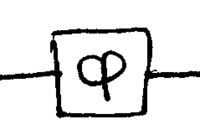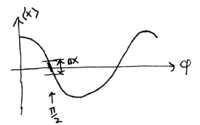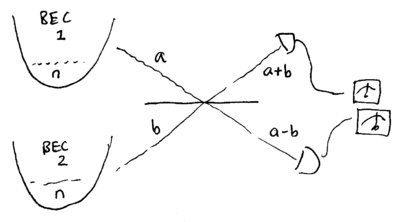Interferometry and metrology
Contents
Quantum states and dynamics of photons
Interferometry and metrology
Suppose you are given a phase shifter of unknown :
\noindent How accurately can you determine , given a certain time, and laser power? In this section, we consider this basic measurement problem, and show how the usual shot noise limit can be exceeded by using quantum states of light, reaching a quantum limit determined by Heisenberg's uncertainty principle. This limit is achieved using entanglement, which can be realized using entangled multi-mode photons, or by a variety of squeezed states. The physics behind such quantum measurement techniques generalizes to a wide range of metrology problems, but a common challenge the need to reduce loss.
Shot noise limit
The Poisson distribution of photon number in coherent (laser) light contributes an uncertainty of to optical measurements. It is therefore reasonable to anticipate that with photons, the uncertainty with which an unknown phase can be determined might be bounded below by , based on the heuristic that . Such a limit is known as being due to shot noise, arising from the particle nature of photons, as we shall now see rigorously. Consider a Mach-Zehnder interferometer constructed from two 50/50 beamsplitters, used to measure :
\noindent Let us analyze this interferometer, first by using a traditional quantum optics approach in the Heisenberg picture, and second by using single photons in the Schrodinger picture. Previously, we've defined the unitary transform for a quantum beamsplitter as being a rotation about the axis, so as to avoid having to keep track of factors of . For variety, let's now use a different definition; nothing essential will change. Let the 50/50 beamsplitter transformation be
This acts on to produce operators describing the output of the beamsplitter; in particular,
Similarly, the phase shifter acting on the mode operators performs
The Mach-Zehnder transform is thus
The way we have defined these transformations here, the output modes of the interferometer, and , are
We are interested in the difference between the photon numbers measured at the two outputs, , where the extra factor of two is introduced for convenience. We find
The measurement result is thus
Define , and . Recognizing that is the difference in photon number between the two output arms, and recalling that this is the main observable result from changing , we identify the signal we wish to see as being . Ideally, the output signal should go as . The signal due to goes as , and we shall see that this is the noise on the signal. The average output signal , as a function of , looks like this:
\noindent Note that if our goal is to maximize measurement sensitivity to changes in , then the best point to operate the interferometer at is around , since the slope is largest there. At this operating point, if the interferometer's inputs have laser light coming into only one port, then the outputs have equal intensity; thus, the interferometer is sometimes said to be "balanced" when . What is the uncertainty in our measurement of , derived from the observable ? By propagating uncertainties, this is
where
Let , such that , and . For a coherent state input, , we find
if we define as the input state mean photon number. Also,
This is consitent with our intuition: the signal should go as , and the undesired term goes as , so it is good that is small on average. However, there are nontrivial fluctuations in , because
and is nonzero for the coherent state! Specifically, the noise in is
and thus the variance in the measurement result is
From Eq.(\ref{eq:l7-dphi}), it follows that the uncertainty in is therefore
This is a very reasonable result; as the number of photons used increases, the accuracy with which can be determined increases with . The improvement arises because greater laser power allows better distinction between the signals in and . Another way to arrive at the same result, using single photons, gives an alternate interpretation and different insight into the physics. As we have seen previously, acting on the , "dual-rail" photon state, a 50/50 beamsplitter performs a rotation, and a phase shifter performs a rotation. The Mach-Zehnder interferometer we're using can thus be expressed as this transform on a single qubit:
\noindent where the probability of measuring a single photon at the output is . Walking through this optical circuit, the states are found to be
such that
Repeating this times (so that we use the same average number of photons as in the coherent state case), we find that the standard deviation in is
Given this, the uncertainty in is
This is the same uncertainty as we obtained for the coherent state input, but the physical origin is different. Now, we see the noise as being due to statistical fluctuations of a Bernoulli point process, one event at a time. The noise thus comes from the amount of time the signal is integrated over (assuming a constant rate of photons). The noise is simply shot noise.
Heisenberg limit: entanglement
The shot noise limit we have just seen, however, is not fundamental. Here is a simple argument that something better should be possible. Recall that the desired signal at the output of our Mach-Zehnder interferometer is , and the noise is . If the inputs have and , and if were zero, then the measured signal would be . And at the balanced operating point ,
Thus, if the smallest photon number change resolvable is , then , from which it follows that
This is known as the "Heisenberg limit" on interferometry. There are some general proofs in the literature that such a limit is the best possible on interferometry. It governs more than just measurements of phase shifters; gyroscopes, mass measurements, and displacement measurements all use interferometers, and obey a Heisenberg limit. The argument above only outlines a sketch for why might be an achievable limt, versus ; it assumes that the noise can be made zero, however, and does not provide a means for accomplishing this in practice. Many ways to reach the Heisenberg limit in interferometry are now known. Given the basic structure of a Mach-Zehnder interferometer,
\noindent one can consider changing the input state , changing the beamsplitters, or changing the measurement. Common to all of these approaches is the use of entangled states. How entanglement makes Heisenber-limited interferometry possible can be demonstrated by the following setup. Let us replace the beamsplitters in the Mach-Zehnder interferometer with entangling and dis-entangling devices:
\noindent Conceptually, the unusual beamsplitters may be the nonlinear Mach-Zehnder interferometers we discussed in Section~2.3. They may also be described by simple quantum circuits, using the Hadamard and controlled-{\sc not} gate; for two qubits, the circuit is
\noindent Note how the output is one of the Bell states. For three qubits, the circuit is
\noindent This output state, (suppressing normalization) is known as a GHZ (Greenberger-Horne-Zeilinger) state. Straightforward generalization leads to larger "Schrodinger cat" states , using one Hadamard gate and controlled-{\sc not} gates. Note that the reversed circuit unentangles the cat states to produce computational basis states. The important feature of such -qubit cat states, for our purpose, is how they are transformed by phase shifters. A single qubit becomes . Similarly, two entangled qubits in the state , when sent through two phase shifters, becomes , since the phases add. And qubits in the state sent through phase shifters becomes . When such a phase shifted state is un-entangled, using the reverse of the entangling circuit, the controlled-{\sc not} gates leave the state , where the last qubits are left in , and the first qubit (the qubit used as the control for the {\sc cnot} gates) is
Compare this state with that obtained from the single qubit interferometer, Eq.(\ref{eq:l7-1qubitphase}); instead of a phase , the qubit now carries the phase . This means that the probability of measuring a single photon at the output becomes
The standard deviation, from repeating this experiment, on average, would be
Using , we obtain for the uncertainty in ,
which meets the Heisenberg limit.
Squeezed light interferometry
Heisenberg-limited interferometry can also be accomplished using a variety of states of light, including squeezed states we studied in Section~2.2. Let us explore three configurations here. Vacuum squeezed state input. Because squeezed states can move noise between the and quadratures, it is intuitively reasonable that a state with low phase noise could be used to provide more accurate measurements of than is possible with a coherent state, which has equal noise in the two quadratures. It might seem counter-intuitive, however, that we can get to the Heisenberg limit by replacing not the coherent state input, but rather, the vacuum state, in the Mach-Zehnder interferometer. This works because at the balanced operating point, the noise in the output is due to fluctuations entering in at the vacuum port. Before, we used as input. Let us now replace this by
where is a squeezed vacuum state. Recall that for the balanced interferometer, the final uncertainty in the phase measurement is
where , and . For the squeezed vacuum + coherent state input, we find
Thus, the uncertainty in the phase measurement is approximately
In the limit of large squeezing, ie , the squeezed vacuum has nonzero average photon number, , so this expression does not vanish to zero. Rather, there is an optimal amount of squeezing, at which point the minimum phase uncertainty goes as , which is close to the Heisenberg limit. See Caves, {\em Quantum-mechanical noise in an interferometer,} Phys. Rev. D, vol~23, p.~1693, 1981, for more on this subject. Yurke state input. The Heisenberg limit can also be reached using the Mach-Zehnder interferometer by replacing the input light states with this unusual squeezed state
This is known as the Yurke state. It happens to be balanced already, and thus instead of operating our interferometer at , we operate it at , such that the output measurement gives , and , and the final uncertainty in the phase measurement is
For the Yurke state,
In calculating , the terms with drop out, leaving us with
Similarly, it is straightforward to show that
Thus, the uncertainty in is
which is (up to a factor of two) the Heisenber limit. Given how useful the Yurke state could be for interferometry, it is meaningful to consider how such a state might be made. One interesting proposal starts with two Bose-Einstien condenstates, prepared in a state of definite atom number, which we may model as two number eigenstates . The two condensates are weakly linked through a tunnel, which we may model as a beamsplitter, and detectors are placed to look for a single atom at the outputs. This is sketched below:
If the top detector clicks, then one atom has left the condensates; however, it is unknown from which it came. The post-measurement state, after this single click, is thus
written unnormalized. Normalized, the proper post-measurement state is
This is the Yurke state. If the bottom detector had clicked instead, we would have obtained instead, which is also useful. Similar techniques, involving beamsplitter mixed detection of spontaneous emission, can be used to entangle atoms (as we shall see later). More about this BEC entanglement method can be found in the literature; see, for example, Castin & Dalibard, Phys. Rev. A vol.~55, p.~4330, 1997, for the proposal to create Yurke states; Vogels, Chin, and Ketterle, Phys. Rev. Lett., vol.~90, p.~030403, 2003, for an experiment in which a squeezed BEC state was generated, and Bouyer and Kasevitch, Phys. Rev. A, vol.~56, p.~R1083, 1997, for a proposal to do Heisenberg limited spectroscopy with BECs.
Sensitivity to loss
Entangled states, while very useful for a wide variety of tasks, including interferometry and metrology, are unfortunately generally very fragile. In particular, entangled photon states degrade quickly with due to loss. Consider, for example, the two-qubit state (suppressing normalization). If one of theses photons goes through a mostly-transmitting beamsplitter, then the photon may be lost; let us say this happens with probability . If a photon is lost, the state collapses into one with one remaining photon, say . This is a product state -- no longer entangled. It is not even a superposition. No photon is lost with probability . Even worse, if both modes suffer potential loss of a photon, then no matter whcih mode looses a photon, the entangled state collapses; this happens even if just one photon is lost. Thus, the state retains some entanglement only with probability . And worst of all, if we have an -photon cat state , and all modes are subject to loss , then useful entanglement is retained only with probability . Due to such loss, the phase measurement uncertainty of an entangled state interferometer will go as
which is clearly undesirable. Some physical systems, however, naturally suffer very little loss, and can keep entangled states intact for long times. Photons unfortunately do not have that feature, but certain atomic states, such as hyperfine transitions, can be very long lived. Thus, many of the concepts derived in the context of quantum states of light, actually turn out to be more useful when applied to quantum states of matter.










![{\displaystyle B={\frac {1}{\sqrt {2}}}\left[{\begin{array}{cc}{1}&{-i}\\{-i}&{1}\end{array}}\right]\,.}](https://wikimedia.org/api/rest_v1/media/math/render/svg/4e2d43ef535ef4f670f31b7ce4cfe7a15c1890f8)
![{\displaystyle [a,b]^{T}}](https://wikimedia.org/api/rest_v1/media/math/render/svg/dcbe0f3bd3d712a823544cc4985e4dbd35b6967d)
![{\displaystyle \left[{\begin{array}{c}{a-ib}\\{b-ia}\end{array}}\right]=B\left[{\begin{array}{c}{a}\\{b}\end{array}}\right]\,.}](https://wikimedia.org/api/rest_v1/media/math/render/svg/74285e68d424d09733069d48c00a49acc738cec9)
![{\displaystyle P=\left[{\begin{array}{cc}{1}&{0}\\{0}&{e^{i\phi }}\end{array}}\right]\,.}](https://wikimedia.org/api/rest_v1/media/math/render/svg/3f0a39e65796a1cc92d0a2ea729186ca5aca7a58)
![{\displaystyle {\begin{array}{rcl}U&=&BPB\\&=&{\frac {1}{2}}\left[{\begin{array}{cc}{1}&{-i}\\{-i}&{1}\end{array}}\right]\left[{\begin{array}{cc}{1}&{0}\\{0}&{e^{i\phi }}\end{array}}\right]\left[{\begin{array}{cc}{1}&{-i}\\{-i}&{1}\end{array}}\right]\\&=&-ie^{i\phi /2}\left[{\begin{array}{cc}{\sin(\phi /2)}&{\cos(\phi /2)}\\{\cos(\phi /2)}&{-\sin(\phi /2)}\end{array}}\right]\,.\end{array}}}](https://wikimedia.org/api/rest_v1/media/math/render/svg/4aff63aa7808a03191a5315b3f548834ce336f41)


![{\displaystyle \left[{\begin{array}{c}{c}\\{d}\end{array}}\right]=U\left[{\begin{array}{c}{a}\\{b}\end{array}}\right]\,.}](https://wikimedia.org/api/rest_v1/media/math/render/svg/c9786a4cebe3997ae8ab2e2a99556bd27a67b002)




























































![{\displaystyle |00\cdots 0{\rangle }[|0\rangle +e^{ni\phi }|1\rangle ]}](https://wikimedia.org/api/rest_v1/media/math/render/svg/6045fc2a6464b6cd42e9fb5c81084a169e808fda)



















![{\displaystyle |\psi _{in}\rangle ={\frac {1}{\sqrt {2}}}\left[{|n-1{\rangle }|n\rangle +|n{\rangle }|n-1\rangle }\right]\,.}](https://wikimedia.org/api/rest_v1/media/math/render/svg/fddaf8eca4a41d65a799f1448a487eafc95e3022)



















